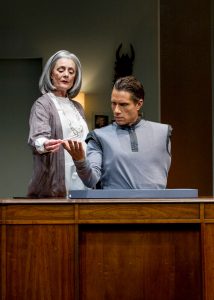‘Uncanny Valley’ at the REP: Neither Frankenstein Nor R2D2
The topic of creating mechanical life holds much fascination in both literature and popular media. There’s everything from Frankenstein’s monster and Pinocchio to the dickering ‘droids in the Star Wars series. Even Disney has gotten into the act, by endlessly endowing plants and animals with human qualities.
The best of these literary depictions also focus on core philosophical questions such as, “How do I understand myself, my own existence,” (which philosophers call ontology), or “How do I know what I know, and how did I learn what I know (epistemology), and “What are my values, how were they formed, and how are they influenced by my relationships and the society in which I live?”
Thomas Gibbons’ engaging new play, Uncanny Valley, which is performing at the San Diego Repertory Theatre as part of a “rolling world premiere” sponsored by a group of regional theatre companies, pecks away at these issues to some degree. Mostly, though, it’s concerned with relationships, both professional and personal, and how human-machine relationships might be possible.
Claire (Rosina Reynolds) is a renowned cognitive neuroscientist living in what Mr. Gibbons calls “The Not Too Distant Future.” She, along with her now-retired husband, made major contributions to understanding how human brains function, how the brain and human behavior are interrelated, and how these understandings can be replicated in machines.
Julian (Nick Cagle) is the latest “product” that is being built by a large and sophisticated engineering design team. He begins as simply a head (credit a clever costume design by Michelle Hunt Souza) and eventually emerges as fully human in appearance. Claire, who is on the verge of retirement, has taken the role of shaping Julian’s knowledge. The designers and programmers have given Julian a vast wealth of information on which to draw. Claire helps Julian to understand how to use that knowledge in social situations, as well as how to refine his communication ability to minimize what is called the “uncanny valley” effect, where humans feel uncomfortable interacting with human-like entities they know to be machines.
Julian’s purpose is to serve the needs of a particular member of the one-percent elite, whose funding has supported the research that’s gone into creating him.
Julian is certainly a machine as the play begins. His movements are jerky and mechanical, and he pauses after Claire speaks, clearly using his computer-brain to access appropriate information. As the technicians add the rest of his body, and Claire’s work takes hold, Julian’s movements become more fluid and his responses become less mechanical. By the time he’s fully formed, Julian has become reasonably facile with interpersonal interaction, though no matter how good he gets there is always a remnant that reminds humans that he is not one of us.
No matter, as it turns out. Julian’s purpose is to serve the needs of a particular member of the one-percent elite, whose funding has supported the research that’s gone into creating him. Claire, who might well have been bothered by such an arrangement at one point in her career, seems to have accepted it without question – until Julian’s purpose confronts her head-on.
Mr. Gibbons is no Tom Stoppard: where Mr. Stoppard may well have used this situation to explore deep questions about the nature of thought and how self-awareness develops, Mr. Gibbons is content to brush over such questions (Julian wonders repeatedly why his eyes are brown, and that’s about as deep as it gets). He’s also content to ignore the ethical questions, and by setting his story in the future he can get away with lack of address implying that these questions have been resolved.
But, differences in values nevertheless are at the heart of what the play ultimately addresses. Mr. Gibbons just leaves it to audiences to sort out those differences, which may be a strength or weakness depending on audience willingness to undertake this task.
In Ms. Reynolds and Mr. Cagle, the REP has found two actors who are up to the task of creating a realistic human-machine relationship. Under Jessica Bird’s careful direction, their interaction early on seems more like an acting exercise than anything else, but that feeling could also have been engendered by the need to help the audience experience the “uncanny valley” of the title. By the time Julian is fully formed and able to act on disclosures that Claire has made, there is still some sense of that the uncanny valley is present, but Claire’s un-ease can also be attributed to the relational position she’s assumed.
Some people find it easier to make themselves vulnerable if they think that they can’t be hurt by what they say. Sometimes, they’re mistaken.
The technical elements (Robin Sanford Roberts’ scenic design, Kristin Swift Hayes’ lighting design, and Kevin Anthenill’s sound design) all feel natural and right for the smaller Lyceum Space theatre in which this production is being staged.
Audiences aren’t going to exit the theatre humming the tunes (we’ll save that for the REP’s Harry Nilsson show, coming up next), but they may give a wider berth to their robotic vacuum cleaner the next time they run it.
[box]Performs Wednesdays at 7pm, Thursdays at 8pm, Fridays at 8pm, Saturdays at 2pm, 4pm, and 8pm, and Sundays at 2pm and 7pm, at the Lyceum Space Theatre, 79 Horton Plaza, in downtown San Diego. Running time is 90 minutes with no intermission. Parking is available in the Horton Plaza garage. Validate at the theatre for four hours of free parking. Tickets range from $31 to $75 and are available by calling (619) 544-1000 or visiting http://www.sdrep.org/.
DOWNLOAD CAST AND CREDITS HERE[/box]

In addition to reviewing theatre for San Diego Story, Bill also reviews for TalkinBroadway.com. He is a member of the San Diego Theatre Critics Circle and the American Theatre Critics Association. Bill is an emeritus professor in the School of Journalism and Media Studies at San Diego State University.




